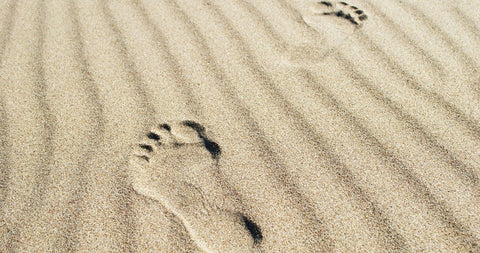
Dog walkers, foot pain and everything you need to know
Walking your dog should be a daily highlight, but what if foot pain is making it tricky to enjoy your regular walkies? Check out our guide and find out everything you need to know about common dog walking injuries – and what you can do to avoid them.
Regular walks are a doggy essential
Walking your dog is about much more than giving them the chance to take a toilet break. Walks offer your four-legged companion all kinds of important benefits, including mental stimulation, physical exercise and time with their favourite person – you!
The Animal Foundation says that walking your dog is essential for helping them stay fit and healthy. Even dogs that are very active at home need the extra exercise offered by a good walk.
Walking is also the perfect time for dogs to socialise with other pooches and humans, helping make them more confident and relaxed. The whole experience is also great for your dog’s wellbeing. They find being outside stimulating and exciting and a regular walking schedule gives them something to look forward to.
Walks let your dog to explore, learn, make friends and soak up the world – make sure you give them the opportunity to live their best doggy life by booking regular walks into your schedule.
Common injuries while dog walking
As with any form of exercise, there’s always a slight risk of injury. However, staying injury-free means you can enjoy the full range of benefits dog walking has to offer, both for your dog and yourself. Regular walking not only keeps your dog healthy, but it also provides an opportunity for bonding, mental stimulation, and exploring new environments together. If foot pain gets in the way, it may limit your ability to provide these essential walks, which are crucial for your dog's physical and mental wellbeing.
Common issues include plantar fasciitis, Achilles tendonitis, pain in foot arches and blisters, all of which can impact your ability to enjoy those daily walks.
That said, walking your dog offers you plenty of benefits too. A recent study from pet food brand Purina found that 82 per cent of owners surveyed said that going on a dog walk allows them to escape from their daily life pressures and improves their mental health. What’s more, 69 per cent said they felt their fitness had improved since getting a dog, while 79 per cent said they become more active outdoors.
Ways to avoid injury while walking your dog
There are a few things you can do to reduce the chance of injury when walking your dog and one of the most important is making sure they are well trained. A dog who is constantly pulling at the leash or who is likely to bolt and pull you along with it is more likely to cause injury.
Another important tip is to stay alert while you’re out walking. Cutting down on distractions and avoiding your phone makes it easier to stay focused on your dog’s behaviour and watch out for tripping hazards. Using a short lead is another good way to make strains, trips and falls less likely.
Preparation is also key and choosing the right pair of shoes can make all the difference. Podiatrists recommend having your shoes fitted properly, especially as your feet can change size and shape over time. Shoes with a good amount of support can help alleviate some of the common problems that can develop when you’re on your feet a lot.
Insoles can also offer extra support for your arches as well as cushion the shock and impact of walking. For example, our In-Balance range, has been designed to support your natural walking style while our Scholl Arch Pain Relief insoles contour to your feet to offer clinically proven pressure relief.
For long walks, you may also benefit from bringing along some Scholl Blister Plasters to apply if you feel a blister forming. They have soft gel island pads made from hydrocolloid technology that are designed to cushion blisters to avoid painful rubbing.
How taking care of your feet benefits your pooch
Taking good care of your feet to avoid pain and injury means that you’re more likely to be able to enjoy the walks your dog needs and loves. A pain-free walk allows you to be more present, giving your dog the attention, exercise, and social interaction that are key to their happiness. Whether it's preventing blisters, choosing supportive shoes, or using insoles, these small adjustments not only help protect your feet but ensure that you and your dog can keep benefiting from your outdoor adventures together.
